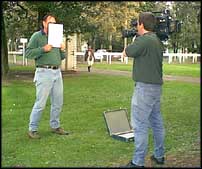White balance basically means colour balance. It is a function which gives the camera a reference to "true white" — it tells the camera what the colour white looks like, so the camera will record it correctly. Since white light is the sum of all other colours, the camera will then display all colours correctly.
Incorrect white balance shows up as pictures with orange or blue tints, as demonstrated by the following examples:
Most consumer-level camcorders have an "auto-white balance" feature, and this is how most amateurs operate. The camera performs it's own white balance without any input from the operator. In fact, very few home-video users are aware of it's existence. Unfortunately, the auto-white balance is not particularly reliable and it is usually preferable to perform this function manually.
The terminology we use at mediacollege.com is as follows:
"Auto-white" means the completely automatic function (no user input at all).
"Manual-white" means the operation described below.
"Colour correction" means any other method of adjusting colours.
You will need:
Incorrect white balance shows up as pictures with orange or blue tints, as demonstrated by the following examples:
 Correct colour balance |  Colour balance too blue |  Colour balance too yellow |
Terminology
To confuse the issue, the term "automatic white balance" has two different interpretations. On consumer-level cameras, it means completely automatic. On professional-level cameras, it can mean the white balance operation as described below (which is actually quite manual). This is because in professional situations, a "manual white balance" can mean altering colours using specialised vision processing equipment.The terminology we use at mediacollege.com is as follows:
"Auto-white" means the completely automatic function (no user input at all).
"Manual-white" means the operation described below.
"Colour correction" means any other method of adjusting colours.
How to Perform a Manual White Balance
You should perform this procedure at the beginning of every shoot, and every time the lighting conditions change. It is especially important to re-white balance when moving between indoors and outdoors, and between rooms lit by different kinds of lights. During early morning and late evening, the daylight colour changes quickly and significantly (although your eyes don't notice, your camera will). Do regular white balances during these periods.You will need:
- A camera with a manual white-balance function. There should be a "white balance" button or switch on your camera.
 If your camera has a filter wheel (or if you use add-on filters), make sure you are using the correct filter for the lighting conditions.
If your camera has a filter wheel (or if you use add-on filters), make sure you are using the correct filter for the lighting conditions.- Point your camera to a pure white subject, so that most of what you're seeing in the viewfinder is white. Opinions vary on just how much white needs to be in the frame - but we've found that about 50-80% of the frame should be fine (Sony recommends 80% of frame width). The subject should be fairly matte, that is, non-reflective.
- Set your exposure and focus.
- Activate the white balance by pressing the button or throwing the switch. The camera may take a few seconds to complete the operation, after which you should get a message (or icon) in the viewfinder.
Hopefully this will be telling you that the white balance has succeeded - in this case, the camera will retain it's current colour balance until another white balance is performed.
If the viewfinder message is that the white balance has failed, then you need to find out why. A good camera will give you a clue such as "colour temperature too high" (in which case change filters). Also try opening or closing the iris a little.

No comments:
Post a Comment